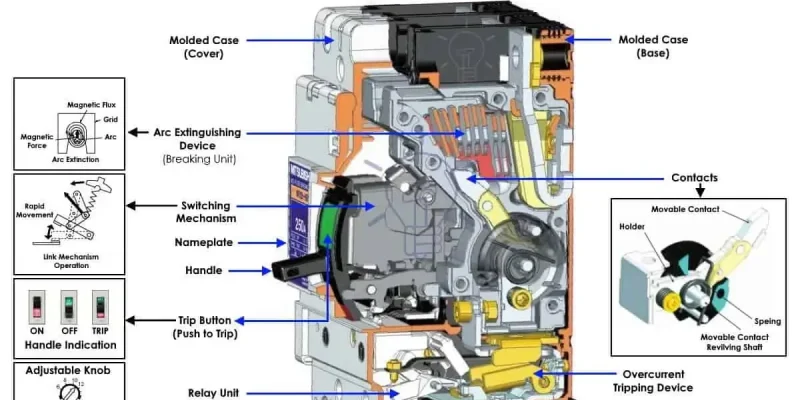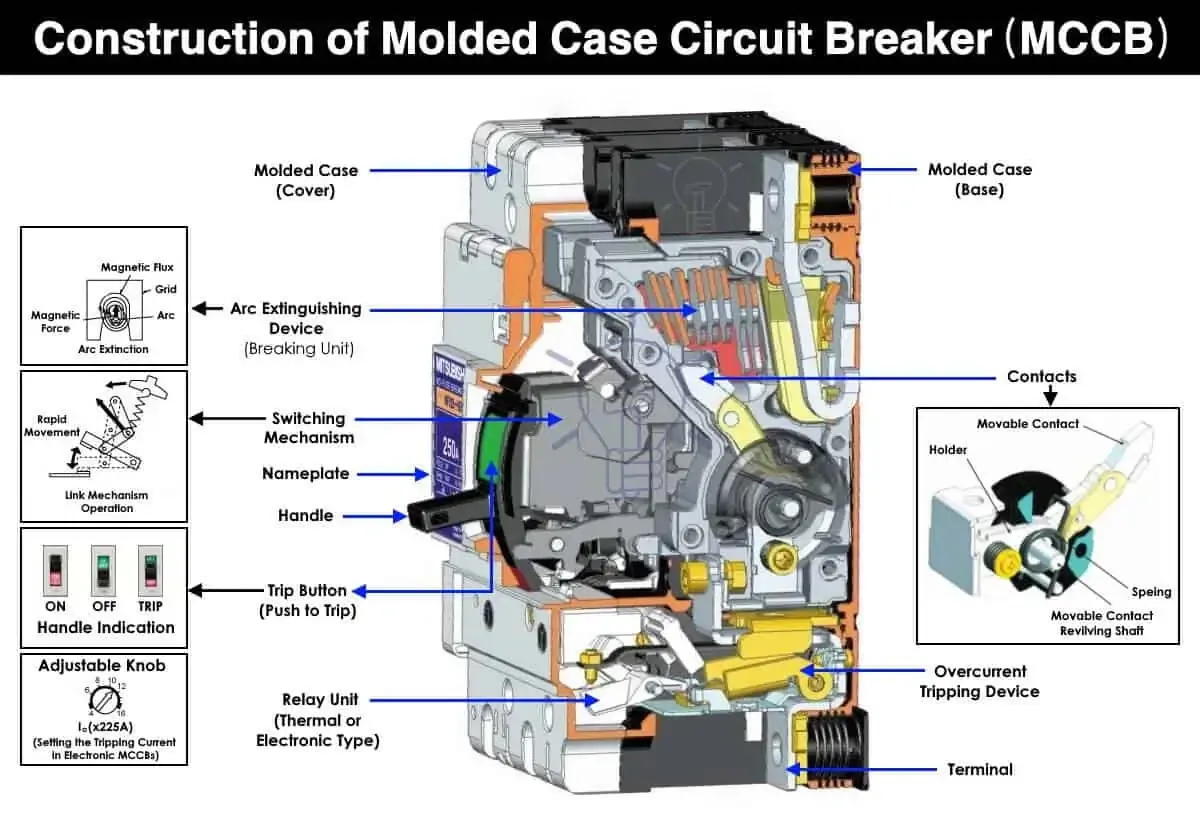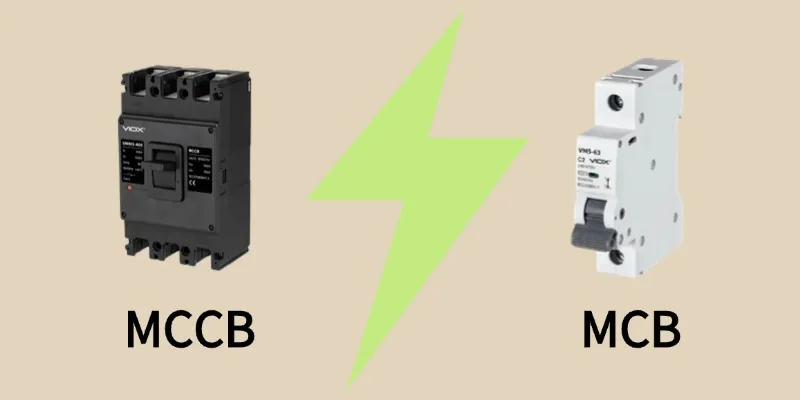Wprowadzenie
Co to jest MCCB
Wyłączniki kompaktowe (MCCB) są krytycznymi komponentami w systemach elektrycznych, zaprojektowanymi do ochrony obwodów przed przeciążeniami i zwarciami. Są one szczególnie cenione w zastosowaniach komercyjnych i przemysłowych ze względu na ich solidną konstrukcję i niezawodność działania.
Budowa wyłączników MCCB
- Formowana obudowa: Zewnętrzna powłoka MCCB, zwykle wykonana z termoutwardzalnej żywicy kompozytowej lub poliestru szklanego, zapewnia wysoką wytrzymałość dielektryczną i chroni wewnętrzne elementy przed czynnikami środowiskowymi.
- Mechanizm wyzwalania: Jest to krytyczna funkcja, która umożliwia wyłącznikowi MCCB przerwanie obwodu w warunkach awarii. Zwykle składa się z:
- Element termiczny: Bimetaliczny pasek, który wygina się pod wpływem ciepła generowanego przez nadmierny prąd, uruchamiając mechanizm wyzwalający. Zapewnia to ochronę przed przeciążeniem, umożliwiając wyłączenie wyłącznika, gdy prąd przekroczy ustawiony poziom.
- Element magnetyczny: Cewka elektromagnetyczna, która generuje pole elektromagnetyczne podczas zwarcia, powodując natychmiastowe wyzwolenie. Ten element zapewnia szybką reakcję na warunki awarii.
- Terminale: Wyłączniki MCCB mają zaciski linii i obciążenia do podłączenia do obwodu elektrycznego. Zaciski te ułatwiają przepływ prądu przez wyłącznik.
- Regulowany prąd znamionowy: Wiele wyłączników MCCB posiada regulowane ustawienia zarówno dla termicznych, jak i magnetycznych mechanizmów wyzwalających, umożliwiając dostosowanie w oparciu o określone charakterystyki obciążenia i wymagania operacyjne.
- Komponenty pomocnicze: Mogą one obejmować:
- Styki pomocnicze: Do celów sygnalizacyjnych lub kontrolnych.
- Styki alarmowe: Wskazuje warunki usterki.
- Zwolnienie bocznika: Do zdalnych operacji wyzwalania.
- Zwolnienie podnapięciowe: Wyzwalanie obwodu w przypadku spadku napięcia.
- Wartości znamionowe wytrzymałości na zerwanie: Wyłączniki MCCB są oceniane pod kątem ich zdolności do bezpiecznego przerywania prądów zwarciowych, z dwoma kluczowymi ocenami:
- Najwyższa zdolność wyłączania zwarć (Icu): Maksymalny prąd zwarciowy, który może zostać przerwany bez uszkodzenia.
- Znamionowa zdolność wyłączania zwarć (Ics): Maksymalny prąd, który może zostać przerwany, nadal umożliwiając wiele operacji po wyzwoleniu.
Zasada działania wyłączników MCCB
Wyłączniki MCCB chronią obwody elektryczne za pomocą dwóch głównych mechanizmów:
- Ochrona termiczna
- Wykorzystuje pasek bimetaliczny
- Wygina się pod wpływem nadmiernego prądu
- Wyzwala wyłącznik w przypadku długotrwałego przeciążenia
- Ochrona magnetyczna
- Wykorzystuje elektromagnes
- Tworzy silne pole magnetyczne podczas zwarć
- Szybko wyłącza wyłącznik w przypadku nagłych, wysokich prądów
Dodatkowe funkcje:
- Styki przewodzące prąd
- System gaszenia łuku w celu bezpiecznego przerwania prądu
- Moduł wyzwalający do monitorowania i sygnalizowania otwarcia styków
Wyłączniki MCCB zapewniają:
- Ochrona przed przeciążeniem (stopniowa reakcja)
- Ochrona przed zwarciem (natychmiastowa reakcja)
- Ręczne sterowanie zapewniające elastyczność operacyjną
Rodzaje wyłączników MCCB
Wyłączniki MCCB są dostępne w kilku konfiguracjach dostosowanych do różnych zastosowań:
- Termiczno-magnetyczny MCCB: Łączy w sobie zarówno termiczne, jak i magnetyczne mechanizmy wyzwalające, zapewniając kompleksową ochronę.
- Elektroniczny MCCB: Zawiera zaawansowaną elektronikę zapewniającą precyzyjne ustawienia wyzwalania i dodatkowe możliwości monitorowania.
- Wyłącznik różnicowoprądowy: Specjalnie zaprojektowany do wykrywania zwarć doziemnych, zwiększając bezpieczeństwo w wrażliwych środowiskach.
Różnica między MCB i MCCB
| Cecha | MCB | MCCB |
|---|---|---|
| Pełny formularz | Miniaturowy wyłącznik automatyczny | Wyłącznik kompaktowy |
| Bieżące oceny | Zwykle do 100 A | Zakres od 10A do 2500A lub więcej |
| Zdolność przerywania | Do 10 kA | Do 100 kA |
| Rozmiar | Kompaktowy i lekki | Większy i bardziej wytrzymały |
| Mechanizm wyzwalający | Stała termiczno-magnetyczna | Termo-magnetyczne i regulowane ustawienia |
| Zastosowania | Mieszkaniowy i lekki komercyjny | Instalacje przemysłowe i duże instalacje komercyjne |
| Koszt | Ogólnie tańsze | Droższe ze względu na większą pojemność |
| Resetowanie | Łatwy do zresetowania bez wymiany | Wymaga ręcznej interwencji w celu zresetowania |
Szczegółowe wyjaśnienie
- Bieżące oceny:
- MCB są przeznaczone do zastosowań o niższym natężeniu prądu, zwykle do 100 A, dzięki czemu nadają się do obwodów domowych.
- MCCBZ drugiej strony mogą obsługiwać znacznie wyższe prądy, od 10 A do 2500 A, co jest niezbędne w zastosowaniach przemysłowych.
- Zdolność przerywania:
- Zdolność przerywania MCB jest zwykle ograniczona do 10 kA, podczas gdy MCCB mogą przerywać prądy zwarciowe do 100 kA, zapewniając lepszą ochronę w scenariuszach dużego obciążenia.
- Rozmiar i konstrukcja:
- MCB są kompaktowe, dzięki czemu idealnie nadają się do instalacji o ograniczonej przestrzeni. Wyłączniki MCCB są większe ze względu na ich solidną konstrukcję potrzebną do obsługi wyższych prądów i napięć.
- Mechanizm wyzwalający:
- MCB mają zwykle stałe ustawienia wyzwalania, które szybko reagują na przeciążenia lub zwarcia. W przeciwieństwie do nich, wyłączniki MCCB oferują regulowane ustawienia wyzwalania, co pozwala na dostosowanie ich do konkretnych wymagań obciążenia.
- Zastosowania:
- Wyłączniki MCB są powszechnie stosowane w budynkach mieszkalnych do ochrony poszczególnych obwodów, podczas gdy wyłączniki MCCB są wykorzystywane w środowiskach przemysłowych, gdzie występują większe obciążenia.
- Rozważania dotyczące kosztów:
- Ze względu na swoje zaawansowane funkcje i większą pojemność, wyłączniki MCCB są zwykle droższe niż MCB, które są opłacalnym rozwiązaniem dla mniejszych systemów elektrycznych.
Kryteria wyboru
Przy wyborze MCCB należy wziąć pod uwagę kilka czynników:
- Aktualna ocena: Wybierz na podstawie maksymalnego oczekiwanego obciążenia; wartości znamionowe zwykle wahają się od 10 A do kilkuset amperów.
- Zdolność łamania: Wskazuje maksymalny prąd zwarciowy, który wyłącznik MCCB może przerwać bez uszkodzenia. Typowe wartości znamionowe obejmują 25 kA, 36 kA i wyższe.
- Napięcie znamionowe: Zapewnić zgodność z napięciem znamionowym instalacji elektrycznej.
Zastosowania
Wyłączniki MCCB są szeroko stosowane w różnych sektorach:
- Budynki mieszkalne: Do ochrony domowych systemów elektrycznych przed przeciążeniami.
- Obiekty komercyjne: Zapewnienie bezpieczeństwa w budynkach biurowych i środowiskach handlowych.
- Ustawienia przemysłowe: Zapewnia solidną ochronę ciężkich maszyn i urządzeń.
Instalacja i konserwacja
Prawidłowa instalacja i konserwacja mają kluczowe znaczenie dla optymalnej wydajności:
- Wykwalifikowany personel: Instalacja powinna być przeprowadzona przez licencjonowanych elektryków zaznajomionych z lokalnymi przepisami.
- Regularna konserwacja: Okresowe kontrole mogą zapobiec awariom i wydłużyć żywotność wyłączników MCCB. Obejmują one kontrolę połączeń, testowanie ustawień wyzwalania i zapewnienie czystości wyłącznika.
Jak testować wyłączniki MCCB
- Test rezystancji izolacji
- Użyj megaomomierza do pomiaru rezystancji między fazami i zaciskami.
- Upewnij się, że spełnia specyfikacje producenta
- Test rezystancji styków
- Pomiar rezystancji na stykach podczas normalnej pracy
- Porównanie z dopuszczalnym zakresem producenta
- Test zadziałania
- Termiczny: Zastosuj prąd znamionowy 300%; sprawdź, czy zadziała w określonym czasie.
- Magnetyczny: Użyj impulsów wysokoprądowych, aby przetestować natychmiastowe wyzwalanie
- Test mechaniczny
- Kilkakrotnie otwórz i zamknij wyłącznik, aby sprawdzić płynność działania.
- Test dielektryczny
- Przyłożenie wysokiego napięcia między zaciskami a masą w celu sprawdzenia wytrzymałości izolacji.
Bezpieczeństwo: Przed testowaniem należy zawsze odłączyć MCCB od zasilania. Postępuj zgodnie z wytycznymi producenta.
Regularne testowanie zapewnia niezawodne działanie MCCB i skuteczną ochronę obwodu.
Producenci i modele wyłączników MCCB
VIOX Electric
Przewaga marki: Chińska marka znana z konkurencyjnych cen, niezawodności i szerokiej gamy produktów.
Zalecane modele:
- VIOX VM1-400L/4300 Wielozadaniowy przemysłowy MCCB
- VIOX VMM3-400 3P 400A MCCB
EATON
Eaton Corporation plc jest globalną firmą zarządzającą energią z siedzibą w Dublinie w Irlandii, specjalizującą się w energooszczędnych rozwiązaniach elektrycznych, hydraulicznych i mechanicznych dla różnych gałęzi przemysłu na całym świecie.
Zalecane modele:
- Wyłącznik 3-biegunowy Eaton FD3020
- Wyłącznik 3-biegunowy Eaton/Cutler-Hammer KD3400
- Wyłącznik 3-biegunowy Eaton HFD3070
ABB
ABB to szwajcarsko-szwedzka międzynarodowa firma z siedzibą w Zurychu w Szwajcarii. Działa głównie w dziedzinie robotyki, silników, energii, automatyki i pociągów kolejowych. Firma odważyła się również na wyścigi samochodowe i była sponsorem tytularnym FIA Formula E Championship w 2017 roku.
Zalecane modele:
- S3N-3P-60A - 3-biegunowy wyłącznik instalacyjny ABB Bolt-On 600V 60A 25kA@480V
- ABB XT1NU3040AFF000XXX Wyłącznik automatyczny w obudowie formowanej
- 1SDA066732R1 ABB - A1N 125 TMF 125-1250 3P F F
Wnioski
Podsumowując, wyłączniki kompaktowe odgrywają kluczową rolę w bezpieczeństwie elektrycznym, zapewniając niezawodną ochronę przed przeciążeniami i awariami. Ich solidna konstrukcja, regulowane funkcje i wszechstronność sprawiają, że są one niezbędnymi komponentami w nowoczesnych systemach elektrycznych.




